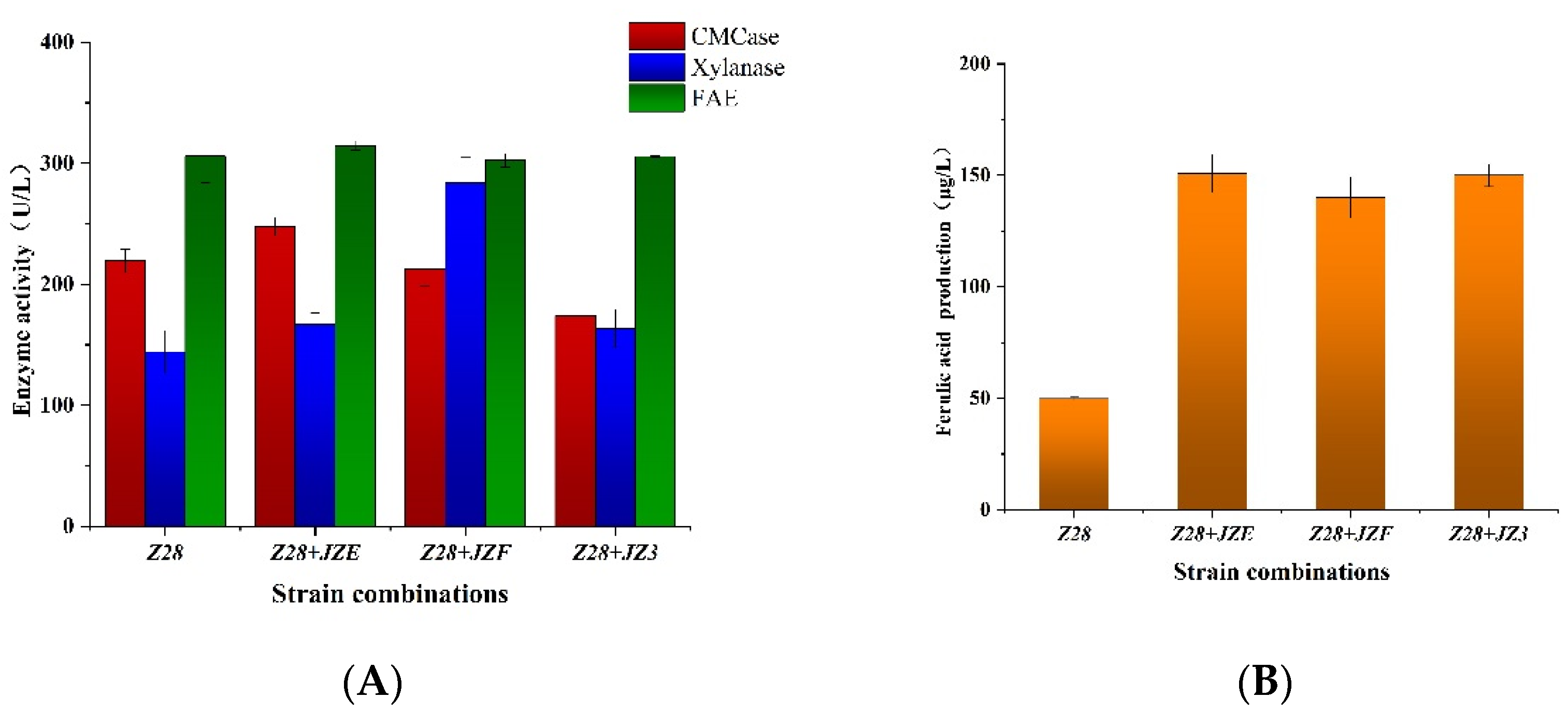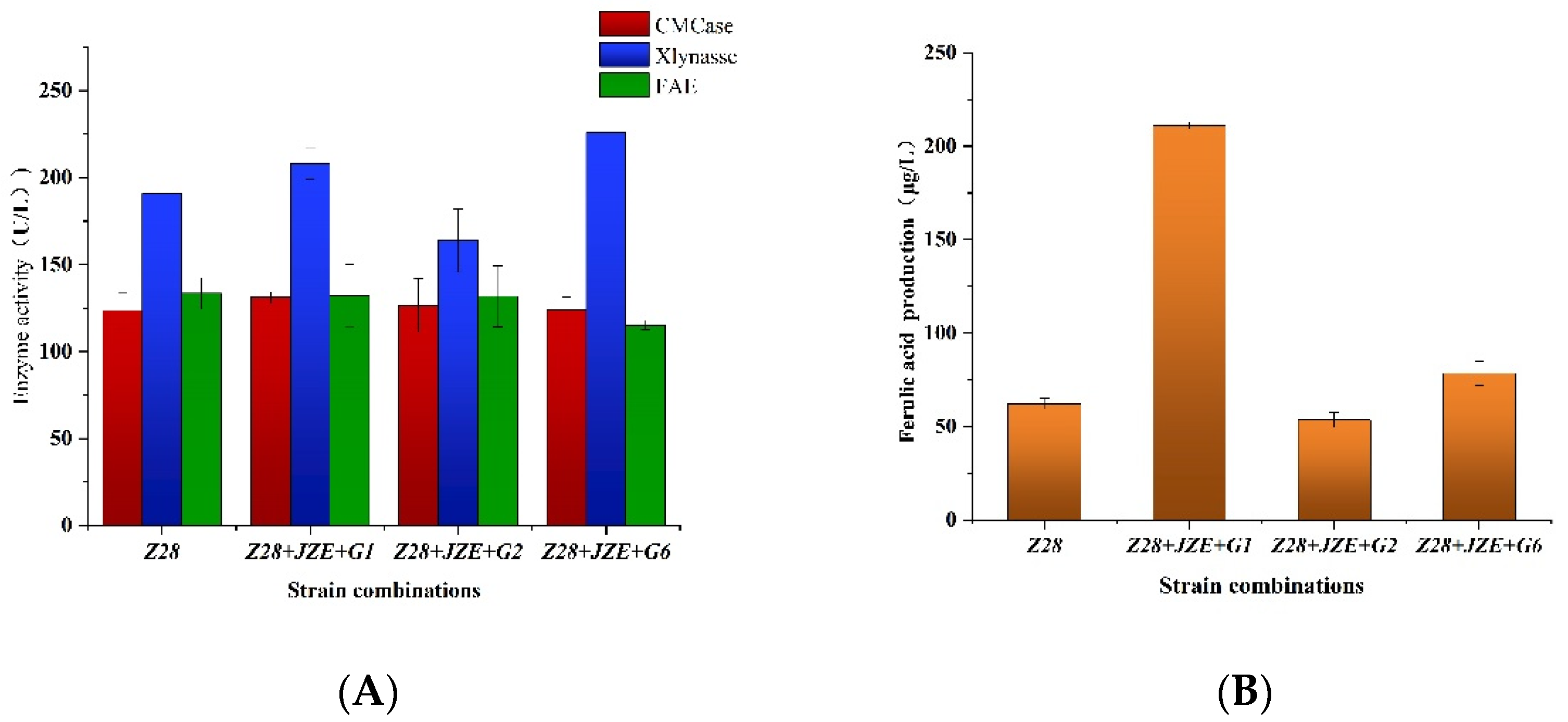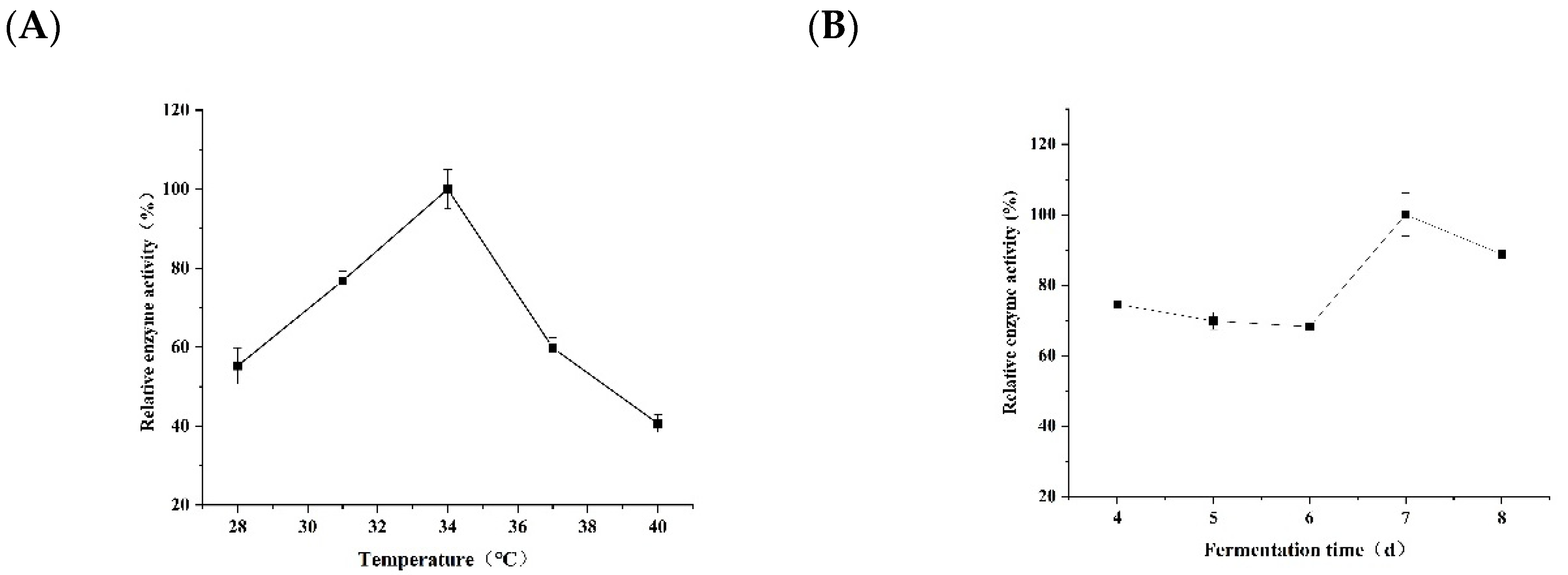The Combined Cultivation of Feruloyl Esterase-Producing Strains with CMCase and Xylanase-Producing Strains Increases the Release of Ferulic Acid
Abstract
:1. Introduction
2. Materials and Methods
2.1. Experimental Materials
2.2. Culture Conditions
2.3. Screening and Identification of Strains
2.4. Combined Fermentation Culture of Micro-organisms
2.5. Single Factor Experiment
2.6. Orthogonal Experiment
2.7. Enzyme Activity Determination
2.8. Experimental Analysis
2.9. Data Processing
3. Results
3.1. Combination Culture of Feruloyl Esterase-Producing Strains and Xylanase-Producing Strains
3.2. Combination Culture of Feruloyl Esterase-Producing Strains and Xylanase and Cellulase Producing Strains
3.3. Single Factor Experiment
3.4. Orthogonal Experiment on Production Rule of Feruloyl Esterase by Strain Combination
3.5. Comparative Analysis of FA Yield before and after Optimization of Optimal Combination Fermentation Conditions
4. Discussion
5. Conclusions
Supplementary Materials
Author Contributions
Funding
Data Availability Statement
Conflicts of Interest
References
- Wang, R.; Yang, J.; Jin, M.J.; Liu, J.; Yuan, H. Efficient ferulic acid and xylo-oligosaccharides production by a novel multi-modular bifunctional xylanase/feruloyl esterase using agricultural residues as substrates. Bioresour. Technol. 2019, 297, 122487. [Google Scholar] [CrossRef] [PubMed]
- Ubando, A.T.; Felix, C.B.; Chen, W.H. Biorefineries in circular bioeconomy: A comprehensive review. Bioresour. Technol. 2020, 299, 122585. [Google Scholar] [CrossRef]
- Shibafuji, Y.; Nakamura, A.; Uchihashi, T.; Sugimoto, N.; Fukuda, S.; Watanabe, H.; Samejima, M.; Ando, T.; Noji, H.; Koivula, A.; et al. Single-molecule imaging analysis of elementary reaction steps of trichoderma reesei cellobiohydrolase i (Cel7A) hydrolyzing crystalline cellulose Iα and IIII. J. Biol. Chem. 2014, 289, 14056–14065. [Google Scholar] [CrossRef] [PubMed]
- Sethupathy, S.; Morales, G.M.; Li, Y.; Wang, Y.; Jiang, J.; Sun, J.; Zhu, D. Harnessing microbial wealth for lignocellulose biomass valorization through secretomics: A review. Biotechnol. Biofuels 2021, 14, 154. [Google Scholar] [CrossRef] [PubMed]
- Kawabata, K.; Yamamoto, T.; Hara, A.; Shimizu, M.; Yamada, Y.; Matsunaga, K.; Tanaka, T.; Mori, H. Modifying effects of ferulic acid on azoxymethane-induced colon carcinogenesis in F344 rats. Cancer Lett. 2000, 157, 15–21. [Google Scholar] [CrossRef]
- Choi, J.-H.; Park, J.-K.; Kim, K.-M.; Lee, H.-J.; Kim, S. In vitro and in vivo antithrombotic and cytotoxicity effects of ferulic acid. J. Biochem. Mol. Toxicol. 2018, 32, e22004. [Google Scholar] [CrossRef] [PubMed]
- Stead, D. The effect of hydroxycinnamic acids and potassium sorbate on the growth of 11 strains of spoilage yeasts J. Appl. Bacteriol. 1995, 78, 82–87. [Google Scholar] [CrossRef]
- Anabela, B.; Carla, F.; Saavedra, M.J.; Manuel, S. Antibacterial activity and mode of action of ferulic and gallic acids against pathogenic bacteria. Microb. Drug Resist. 2013, 19, 256–265. [Google Scholar]
- Anabela, B.; Saavedra, M.J.; Manuel, S. The activity of ferulic and gallic acids in biofilm prevention and control of pathogenic bacteria. Biofouling 2012, 28, 755–767. [Google Scholar]
- Nieter, A.; Kelle, S.; Linke, D.; Berger, R.G. Feruloyl esterases from Schizophyllum commune to treat food industry side-streams Bioresour. Technol. 2016, 220, 38–46. [Google Scholar]
- Damásio, A.R.L.; Braga, C.M.P.; Brenelli, L.B.; Citadini, A.P.; Mandelli, F.; Cota, J.; de Almeida, R.F.; Salvador, V.H.; Paixao, D.A.A.; Segato, F.; et al. Biomass-to-bio-products application of feruloyl esterase from Aspergillus clavatus. Appl. Microbiol. Biotechnol. 2013, 97, 6759–6767. [Google Scholar] [CrossRef] [PubMed]
- Wu, H.; Li, H.; Xue, Y.; Luo, G.; Gan, L.; Liu, J.; Mao, L.; Long, M. High efficiency co-production of ferulic acid and xylooligosaccharides from wheat bran by recombinant xylanase and feruloyl esterase. Biochem. Eng. J. 2017, 120, 41–48. [Google Scholar] [CrossRef]
- Duan, X.; Dai, Y.; Zhang, T. Characterization of Feruloyl Esterase from Bacillus pumilus SK52.001 and Its Application in Ferulic Acid Production from De-Starched Wheat Bran. Foods 2021, 10, 1229. [Google Scholar] [CrossRef] [PubMed]
- De Oliveira, D.M.; Finger-Teixeira, A.; Rodrigues Mota, T.; Salvador, V.H.; Moreira-Vilar, F.C.; Correa Molinari, H.B.; Craig Mitchell, R.A.; Marchiosi, R.; Ferrarese-Filho, O.; Dantas dos Santos, W. Ferulic acid: A key component in grass lignocellulose recalcitrance to hydrolysis. Plant Biotechnol. J. 2015, 13, 1224–1232. [Google Scholar] [CrossRef] [PubMed]
- Liang, J.; Fang, X.; Lin, Y.; Wang, D. A new screened microbial consortium OEM2 for lignocellulosic biomass deconstruction and chlorophenols detoxification J. Hazard. Mater. 2018, 347, 341–348. [Google Scholar] [CrossRef]
- Wang, Y.; Zhao, C.; Zhang, D.; Zhao, M.; Zheng, D.; Peng, M.; Cheng, W.; Guo, P.; Cui, Z. Simultaneous degradation of aflatoxin B1 and zearalenone by a microbial consortium. Toxicon 2018, 146, 69–76. [Google Scholar] [CrossRef]
- Guo, W.; Zhang, Y.; Zhang, X.; Yang, L. Screening of acid cellulase strain degradation resistance in bamboo rats and study on enzymatic properties. Feed Res. 2021, 44, 65–69. [Google Scholar]
- Zhang, Y.; Yang, L.; Zhang, X.; Feng, Z.; Yang, L. Screening ofAlkaline Tolerant Xylanase Strains in Bamboo Rat Intestines and Study on Enzymatic Properties. Sci. Technol. Food Ind. 2021, 42, 118–125. [Google Scholar]
- Malhotra, G.; Chapadgaonkar, S. Production of thermo-alkali-stable xylanase from bacillus licheniformis isolated from natural hot water geyser. J. Microsc. Ultrastruct. 2021, 9, 131–135. [Google Scholar]
- Li, F.; Xie, Y.; Gao, X.; Shan, M.; Sun, C.; Niu, Y.D.; Shan, A. Screening of cellulose degradation bacteria from Min pigs and optimization of its cellulase production. Electron. J. Biotechnol. 2020, 48, 29–35. [Google Scholar]
- Ghose, T.K. Measurement of cellulase activities. Pure Appl. Chem. 2013, 59, 257–268. [Google Scholar] [CrossRef]
- Ding, C.; Li, M.; Hu, Y. High-activity production of xylanase by Pichia stipitis: Purification, characterization, kinetic evaluation and xylooligosaccharides production. Int. J. Biol. Macromol. 2018, 117, 72–77. [Google Scholar] [CrossRef] [PubMed]
- Liu, S.; Bischoff, K.M.; Anderson, A.M.; Rich, J.O. Novel Feruloyl Esterase from Lactobacillus fermentum NRRL B-1932 and Analysis of the Recombinant Enzyme Produced in Escherichia coli. Appl. Environ. Microbiol. 2011, 82, 5068–5076. [Google Scholar] [CrossRef] [PubMed]
- Wang, H.; Xianghui, Q.; Gao, S.; Zhang, Y.; An, Y. Biochemical characterization of an engineered bifunctional xylanase/feruloyl esterase and its synergistic effects with cellulase on lignocellulose hydrolysis. Bioresour. Technol. 2022, 355, 127244. [Google Scholar] [CrossRef]
- Yang, Y.; Zhu, N.; Yang, J.; Lin, Y.; Liu, J.; Wang, R.; Wang, F.; Yuan, H. A novel bifunctional acetyl xylan esterase/arabinofuranosidase from Penicillium chrysogenum P33 enhances enzymatic hydrolysis of lignocellulose. J. Microb. Cell Factories 2017, 16, 166. [Google Scholar] [CrossRef]
- Xu, Z.; He, H.; Zhang, S.; Guo, T.; Kong, J. Characterization of Feruloyl Esterases Produced by the Four Lactobacillus Species: L. amylovorus, L. acidophilus, L. farciminis and L. fermentum, Isolated from Ensiled Corn Stover. Front. Microbiol. 2017, 8, 941. [Google Scholar] [CrossRef]
- Wu, Z.; Yang, S.; Xu, L.; Li, H.; Sun, J.; Xu, Y.; Huang, M.; Sun, B. Screening and identifying microorganisms with feruloyl esterase activity in Chinese sesame-flavour baijiu fermentation materials (Jiupei). J. Food Compos. Anal. 2021, 102, 104069. [Google Scholar] [CrossRef]
- R. F.H, D. Bioconversion of hemicellulose: Aspects of hemicellulase production by Trichoderma reesei QM 9414 and enzymic saccharification of hemicellulose. Biotechnol. Bioeng. 1983, 25, 1127–1146. [Google Scholar] [CrossRef]
- Long, L.; Wu, L.; Lin, Q.; Ding, S. Highly Efficient Extraction of Ferulic Acid from Cereal Brans by a New Type A Feruloyl Esterase from Eupenicillium parvum in Combination with Dilute Phosphoric Acid Pretreatment. Appl. Biochem. Biotechnol. 2020, 190, 1561–1578. [Google Scholar] [CrossRef]
- Zhenshang, X.; Ting, W.; Susu, Z. Extracellular secretion of feruloyl esterase derived from Lactobacillus crispatus in Escherichia coli and its application for ferulic acid production. Bioresour. Technol. 2019, 288, 121526. [Google Scholar]





| Level | Fermentation Time/d | pH | Temperature/°C |
|---|---|---|---|
| 1 | 6 | 7.0 | 31 |
| 2 | 7 | 8.0 | 34 |
| 3 | 8 | 9.0 | 37 |
| Test No. | A pH | B Fermentation Time/d | C Temperature/°C | FAE/U/L |
|---|---|---|---|---|
| 1 | 7 | 6 | 31 | 163.05 |
| 2 | 7 | 7 | 34 | 111.91 |
| 3 | 7 | 8 | 37 | 124.96 |
| 4 | 8 | 6 | 34 | 215.94 |
| 5 | 8 | 7 | 37 | 107.33 |
| 6 | 8 | 8 | 31 | 146.47 |
| 7 | 9 | 6 | 37 | 179.26 |
| 8 | 9 | 7 | 31 | 121.43 |
| 9 | 9 | 8 | 34 | 143.65 |
| K1 | 133.31 | 186.08 | 143.65 | |
| K2 | 156.58 | 113.56 | 157.17 | |
| K3 | 148.11 | 138.36 | 137.18 | |
| R | 23.27 | 72.53 | 19.98 |
Publisher’s Note: MDPI stays neutral with regard to jurisdictional claims in published maps and institutional affiliations. |
© 2022 by the authors. Licensee MDPI, Basel, Switzerland. This article is an open access article distributed under the terms and conditions of the Creative Commons Attribution (CC BY) license (https://creativecommons.org/licenses/by/4.0/).
Share and Cite
Zhang, Y.; Jiang, Z.; Li, Y.; Feng, Z.; Zhang, X.; Zhou, R.; Liu, C.; Yang, L. The Combined Cultivation of Feruloyl Esterase-Producing Strains with CMCase and Xylanase-Producing Strains Increases the Release of Ferulic Acid. Microorganisms 2022, 10, 1889. https://doi.org/10.3390/microorganisms10101889
Zhang Y, Jiang Z, Li Y, Feng Z, Zhang X, Zhou R, Liu C, Yang L. The Combined Cultivation of Feruloyl Esterase-Producing Strains with CMCase and Xylanase-Producing Strains Increases the Release of Ferulic Acid. Microorganisms. 2022; 10(10):1889. https://doi.org/10.3390/microorganisms10101889
Chicago/Turabian StyleZhang, Yao, Zhilin Jiang, Yunran Li, Zhiping Feng, Xian Zhang, Ruiping Zhou, Chao Liu, and Lijuan Yang. 2022. "The Combined Cultivation of Feruloyl Esterase-Producing Strains with CMCase and Xylanase-Producing Strains Increases the Release of Ferulic Acid" Microorganisms 10, no. 10: 1889. https://doi.org/10.3390/microorganisms10101889
APA StyleZhang, Y., Jiang, Z., Li, Y., Feng, Z., Zhang, X., Zhou, R., Liu, C., & Yang, L. (2022). The Combined Cultivation of Feruloyl Esterase-Producing Strains with CMCase and Xylanase-Producing Strains Increases the Release of Ferulic Acid. Microorganisms, 10(10), 1889. https://doi.org/10.3390/microorganisms10101889






